|

by Larry Brian Radka
from
EinhornPress Website
|
ABOUT THE AUTHOR
Larry Brian Radka
is a retired broadcast engineer, an amateur radio
operator (KB3ZU), and a graduate of the University of
the State of New York. He has written several magazine
articles as well as a few books. Historical Evidence for
Unicorns and Astronomical Revelations or 666 were
published in the mid 1990's and his latest release, in
2006, is The Electric Mirror on the Pharos Lighthouse
and Other Ancient Lighting. It may be ordered by
clicking:
http://einhornpress.com/mirror.aspx.
(A similar article by
Larry appeared in David Hatcher Childress's World
Explorer magazine recently) |
"Electric batteries, 2000 years ago!!! Surprised? No need to be,
really," declared Willard F. M. Gray, an electrical
engineer for General Electric.
"There were some pretty smart metal
workers in the ancient city of Baghdad, Persia [now Iraq]. They
did a lot of fine work in steel, gold, and silver. You may
wonder what this had to do with electric batteries. It seems
that copper vases, some of whose ages go back 4000 years, were
unearthed several years ago which had designs plated on them in
gold or silver, even some were plated with antimony."
In his editorial titled "A Shocking
Discovery," in a 1963 edition of the prestigious Journal of the
Electrochemical Society, he also added:
"Occasionally, we feel a bit smug
about our tremendous advances in the nuclear science and the
like, but when we are scooped by some ancient metal smiths we
are most assuredly brought down to earth and humbled. It will
ever be so." [i]
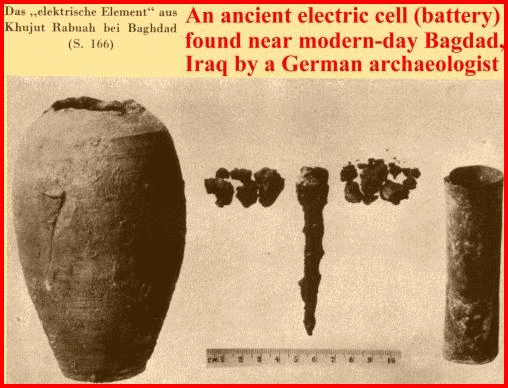
These so-called Baghdad batteries,
discovered in the 1930's, are now old news, and the evidence that
the ancients used them to electroplate some of the artifacts stored
in museums around the world is likewise common knowledge.
Nevertheless, for readers who are not
familiar with the discovery of these ancient electric cells, we will
call on the German rocket scientist Willy Ley to update us.
In a 1939 article in Astounding
magazine, he wrote:
"Dr. Wilhelm Koenig of the
Iraq Museum in Bagdad reported recently that a peculiar
instrument was unearthed by an expedition of his museum in the
summer of 1936. The find was made at Khujut Rabu'a, not far to
the southeast of Bagdad. It consisted of a vase made of clay,
about 14 centimeters high and with its largest diameter 8
centimeters.
The circular opening at the top of
the vase had a diameter of 33 millimeters. Inside of this vase a
cylinder made of sheet copper of high purity was found - the
cylinder being 10 centimeters high and having a diameter of
about 26 millimeters, almost exactly 1 inch.
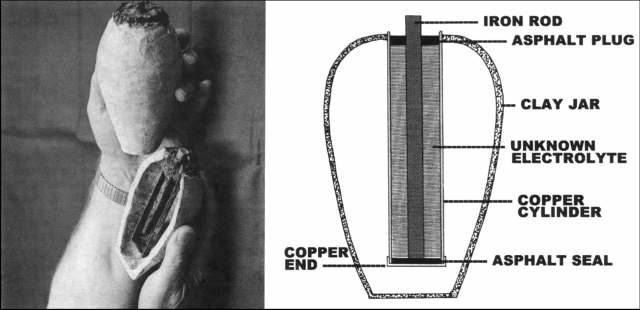
A replica and
diagram of one of the ancient electric cells (batteries) found
near Bagdad
"The lower end of the copper
cylinder was covered with a piece of sheet copper, the same
thickness and quality as the cylinder itself.
The inner surface
of this round copper sheet - the one that formed the inner bottom
of the hollow cylinder - was covered with a layer of asphalt, 3
millimeters in thickness. A thick, heavy plug of the same
material was forced into the upper end of the cylinder.
The center of the plug was formed by
a solid piece of iron - now 75 millimeters long and originally a
centimeter or so in diameter. The upper part of the iron rod
shows that it was at first round, and while the lower end has
partly corroded away so that the rod is pointed now at the lower
end, it might be safely assumed that in the beginning it was of
uniform thickness.
"An assembly of this kind cannot very well have any other
purpose than that of generating a weak electric current. If one
remembers that it was found among undisturbed relics of the
Parthian Kingdom - which existed from 250 B.C. to 224 A.D. - one
naturally feels very reluctant to accept such an explanation,
but there is really no alternative.
The value of this discovery
increases when one knows that four similar clay vases were found
near Tel'Omar or Seleukia - three of them containing copper
cylinders similar to the one found at Khujut Rabu'a. The
Seleukia finds were, apparently, less well preserved - there are
no iron rods in evidence any more. But close to those four vases
pieces of thinner iron and copper rods were found which might be
assumed to have been used as conductive wires.
"Similar 'batteries' were also found in the vicinity of Bagdad
in the ruins of a somewhat younger period. An expedition headed
by Professor Dr. E. Kühnel, who is now director of the
Staatliches Museum in Berlin, discovered very similar vases
with copper and iron parts, at Ktesiphon - not far from Bagdad.
These finds date from the time when the dynasty of the
Sassanides ruled Persia and the neighboring countries - 224
A.D. - 651 A.D.
"While the probable date of the invention is entirely open to
conjecture, it seems likely that it was made in or near Bagdad,
since all known finds were made in the vicinity of this city. It
must be assumed, of course, that the subjects of the Sassanides
had some use for them, and Dr. Koenig, the discoverer of the
best preserved of all these vases, suggests that this use might
still be in evidence in Bagdad itself.
He found that the silversmiths of
Bagdad use a primitive method of electroplating their wares. The
origin of their method cannot be ascertained and seems to date
back a number of years. Since galvanic batteries of the type
found would generate a sufficiently powerful current for
electrogilding small articles fashioned of silver, it might very
well be that the origin of the method has to be sought in
antiquity." [ii]

Click above image
A Simple low-voltage
electric cell and a simple electroplating bath and procedure
Electrogilding or electroplating
basically only requires rods or wire, a couple of simple electric
cells (batteries) connected to a bath of common chemicals wherein
the items to be electroplated are placed.
However, beside the materials already
mentioned, using glass, lead, zinc, and some types of electrolytes
like caustic soda and sulfuric acid produce stronger types of
non-rechargeable Bagdad-types of primary batteries - as well as
powerful rechargeable storage or secondary batteries that could have
been used for ancient electric lighting.
The ancients had access to all of these materials:
-
Bronze Age people made
glass around 3,000 B.C., and the Egyptians manufactured
glass beads about 2,500 B.C. Later, Alexandrians
manufactured modern types of glass, during the Ptolemaic
period - when the Pharos Lighthouse rose up.
-
Prehistoric man smelted
Lead. One old piece of lead work in the British Museum dates
back to 3,800 B.C. Several millenniums later, Romans were
using it at length in their cooking pots, tankards, and
plumbing; and many probably poisoned their brains in the
process. The resulting insanity may have eventually
contributed to the fall of the empire.
With regards to ancient zinc, Rene
Noorbergen, pointed out:
"In 1968, Dr. Koriun Megurtchian
of the Soviet Union unearthed what is considered to be the
oldest large-scale metallurgical factory in the world at
Medzamor, in Soviet Armenia. Here, 4,500 years ago, an unknown
prehistoric people worked with over 200 furnaces, producing an
assortment of vases, knives, spearheads, rings, bracelets, etc.
The Medzamor craftsmen wore
mouth-filters and gloves while they labored and fashioned their
wares of copper, lead, zinc, iron, gold, tin, manganese and
fourteen kinds of bronze. The smelters also produced an
assortment of metallic paints, ceramics and glass."
[iii]
In the course of the excavation of the
Agora in Athens, a roll of sheet zinc, 98% pure, was supposedly
found in a sealed deposit dating from the 3rd or 2nd century B.C.
Fragments of a zinc coffin was reported to have fairly recently been
discovered in Israel, which, judging by an artifact found nearby,
dates back to 50 B.C.
Caustic soda and lye are synonymous.
"Clothes were cleansed in
antiquity," according to Charles Singer, by "lye from
natron or wood-ash," [iv]
so it was available for use as an electrolyte to activate
powerful electric cells in antiquity.
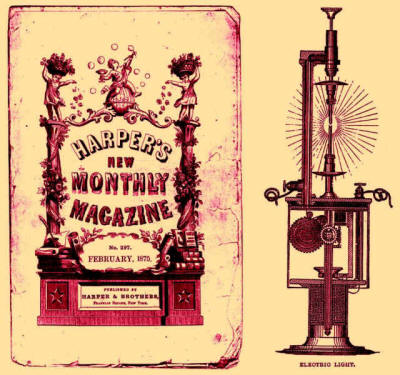
A carbon arc light
popular in the 19th century, illustrated in the issue 1875 issue
above
Manmade sulfuric acid (sulphuric
acid) has been around at least since the seventh century B.C., and
natural sulfuric acid has been available to use as an electrolyte
for countless years before then.
An article in Harper's New
Monthly Magazine, under the title of "Secretion of Sulfuric Acid
by Mollusks," points to where both modern and ancient man could have
obtained natural sulfuric acid.
This quaint publication, which often
serves as an excellent source of rare historical information,
related:
"The remarkable fact was announced
some years ago that certain gastropod mollusca secrete
free sulfuric acid; and this has since then been not
infrequently observed in the case of the gigantic Dolium
galea, which discharges from its proboscis a drop of liquid
or saliva that produces a very sensible effervescence on chalk
or marble.
This secretion from different
mollusca, carefully analyzed, showed a considerable percentage
of free sulphuric acid, some of combined sulphuric acid,
combined chlorohydric acid, with potassa, soda, magnesia, and
other substances; the glands secreting the liquids constituting
from 7 to 9 per cent of the total weight of the animal. With
this acid secretion there is, at least in some species, an
evolution of pure carbonic gas, one gland, weighing
approximately about 700 grains, yielding 206 cubic centimeters.
The genera so far known to furnish
this secretion are Dolium, Cassis, Tritonium, Cassidaria,
Pleurobranchidium, Pleurobranchus, and Doris. The precise object
of this secretion is not entirely understood, although it is
suggested that it is used in perforating the bivalve shells or
other mollusca which serve as article of food."
[v]
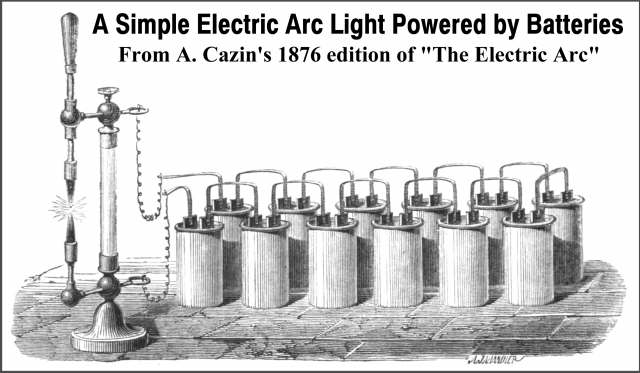
However, the ancients probably did not
need to rely on any natural source of sulfuric acid for the
electrolyte in their batteries.
They likely, as today, relied on
their ingenuity to manufacture their own.
Speaking of the ancient Assyrians (of
Iraq) and the chemicals they produced by 650 B.C., in a paper read
before the Society for the Study of Alchemy and Early Chemistry,
Doctor Reginald Campbell Thompson, the author of A
Dictionary of Assyrian Chemistry and Geology, informs us that:
"The sources from which our
knowledge of Assyrian Chemistry is obtained are a very small
part of the collections of cuneiform tablets in our museums,
which may perhaps be reckoned at a quarter of a million roughly
in number, and of this chemistry, almost all our knowledge comes
from tablets of the Seventh Century B.C.
But that the ancient Sumerians had a
very practical knowledge of chemical methods even before the
invention of writing, let us say, very early in the Fourth
Millennium B.C., is to be inferred from the beautiful gold work
found by Sir Leonard Wooley at Ur, and the copper and
bronze castings found throughout Southern Mesopotamia.
The written word, however, of their
methods has survived only sparsely by comparison, this being due
to three causes: first, the illiteracy of the craftsmen;
secondly, the habit of all Guilds to conceal their methods by
the use of cryptic expressions; and thirdly, the close guarding
of secrets, which were frequently handed down from father to son
by word of mouth.
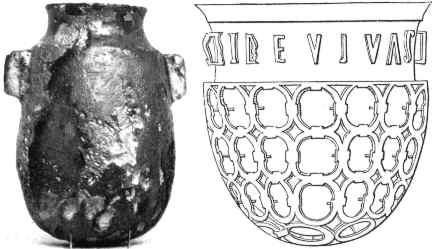
A Sargon II
(722-705 BC) era glass jug and first century transparent glass
vase
"In the Seventeenth Century B.C. we
have a text of outstanding importance for the history of
Chemistry in a tablet written by a glass-maker. Later on, in the
Seventh Century, we have a collection of glass recipes made at
the instance of King Ashurbanipal (668 - 626 B.C.).
More generally we have a large
collection of medical texts which allow us to identify numerous
substances in use during the First Millennium B.C. Finally I
must mention numerous Sumero-Assyrian dictionaries which give
lists of chemical words, also dating from the same period.
"By 650 B.C. the list of chemicals may be said to include Common
Salt, Sal gemma, red Sal Gemma, Lime, Saltpeter from the earth,
Carbonate of Soda from the walls, Nitrate of Potash from walls,
Sal Ammoniac from plants, Gypsum, Mercury from cinnabar, Alum,
Black and Yellow Sulphur, Bitumen, various forms of Arsenic, red
and black Copper Oxide, Chrysocolla, Haematite, Magnetic Iron
Ore, Iron Pyrites (which leads to Vitriols), Iron Sulphide,
Copper Sulphate; and if I am right, they had a word hannabahru
for the fuming sulphuric acid from Green Vitriol."
[vi]
Now that we have established that the
ancients also possessed all of these chemicals, including Sal
Ammoniac and sulphuric acid, which are excellent
battery-making materials, we need to look at least one example of a
primary and second type of powerful battery that they could have
easily produced to energize their ancient electric lights.
One example of a powerful primary battery that the ancients could
have manufactured, using caustic soda or some equivalent, is the
Lalande Battery.
Felix Lalande and Georges
Chaperon used a similar electrolyte to produce their primary
battery in the nineteenth century, and it supplied enough current to
power electric railroad lights for many days before it needed to be
restored. Likewise, several large Lalande cells placed in series and
parallel could have supplied enough voltage and current to power
bright lights in antiquity for a long time before any of the
battery's elements would have needed replacing.
This type of battery needs no external
source of electricity to revitalize it. After it has discharged,
replacing some of its internal ingredients restores the unit to full
capacity.
In an Encyclopaedia Britannica
article published in 1929, G. W. Heise, a research chemist at
the National Carbon Company of Cleveland, Ohio, and an author
of numerous articles in technical journals, explained the
"heavy-duty characteristics" of this primary battery - which would
certainly qualify it for carbon arc light usage in the searchlight
on the ancient Pharos Lighthouse.
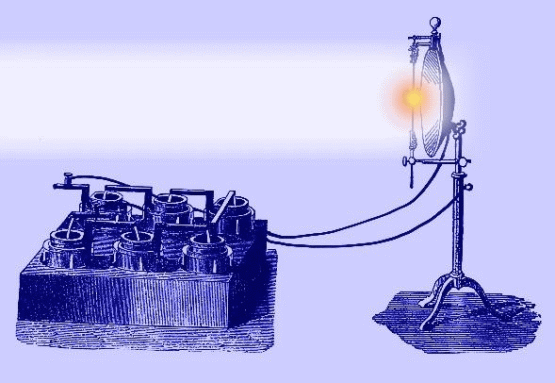
An animated
illustration of a simple battery powered searchlight or electric
mirror
He maintained:
"The Lalande cell is one of the most
efficient and satisfactory primary batteries known today for the
special classes of service to which it is suited. It lends
itself readily to rugged construction; it is relatively cheap to
make and operate; it is very reliable in its action and has a
high current output per unit of volume (about 1 ampere hour per
8 cc. of electrolyte). The cell is made in units as large as 500
to 1,000 ampere hour sizes.
Because it requires no attention for
long periods of time and because of its excellent continuous
discharge and heavy-duty characteristics, the Lalande cell is at
present much used in railway signal operation. It can be made in
dry or non-spillable form either by gelatinizing the caustic
soda solution with small quantities of starch or by using such
expedients as making a paste out of electrolyte and magnesium
oxide.
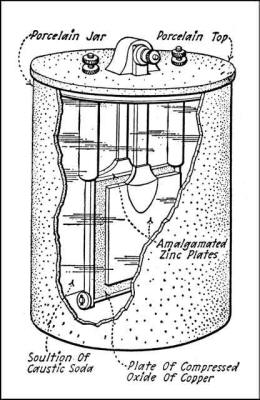
An Edison or
Lalande battery, a powerful primary electric cell
"Air cells of the Lalande type, in
which a porous carbon accessible to air is substituted for the
usual copper oxide element, are also feasible. These have an
even more horizontal discharge curve than the copper oxide cell,
since the potential of the cathode remains virtually unchanged
during service life.
The caustic soda air cell has an
open circuit voltage of 1.35 to 1.45 and an operating voltage
even on comparatively heavy drains above 1.0 volt - perhaps 0.4
to 0.5 volt higher than that of a standard copper oxide cell.
The carbon electrode can be used repeatedly, only zinc and
electrolyte requiring renewal each time the cell is completely
discharged." [vii]
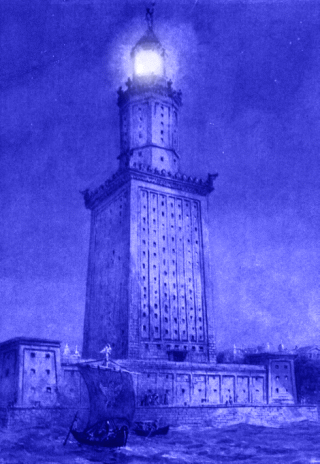
An animated picture
of the Pharos Lighthouse
A railroad signal light sending
directions down the track, like the Pharos flashed it messages over
the sea, certainly demanded their periodic renewal, but eventually a
more practical and economical source of illuminating power, the
lead-acid secondary storage battery took its place.
This powerhouse is easy to build, by
immersing two lead plates in a solution of sulfuric acid in a glass
container, all of which the ancients possessed. However, before a
simple storage cell will produce electric current, it needs charged.
To initially energize it, you need only to connect it to a source of
direct current, like a primary battery or thermocouple.
We already know the ancients manufactured primary cells, like the
Baghdad batteries, that serve the purpose, but they could have
easily used a thermo-electric generator, which is a simple device to
make.
They merely had to heat one of two
dissimilar metallic conductors joined together, like copper and
iron, to create a thermo-electric generator, which is also called a
thermopile and thermo-electric stove.
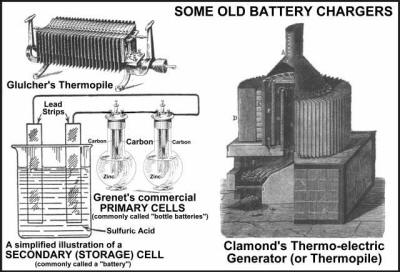
The Gülcher Thermopile, being
more convenient, less costly, and cleaner than primary batteries,
was a popular means of charging storage batteries in the nineteenth
century.
It gave on a short circuit about 5
amperes of current at 4 volts. However, this thermo-electric
generator hardly compared to the power output of the improved
Clamond Thermopile of 1879, which produced 109 volts, with an
internal resistance of 15.5 ohms.
It could easily illuminate bright
electric lights and also deliver a lethal dose of energy! In 1893,
Dr. Giraud's Thermo-electric stove, 3 feet high and 20 inches in
diameter and fired by coal, not only could charge batteries but
could also light several electric lamps, as well as heat a room 21
feet square. It was an expensive unit to build but cost would have
been no obstacle for a wealthy ruler of any ancient city like
Alexandria.
The ancient Greek kings ruling that city
may well have relied on similar types of thermopiles to charge
powerful lead-acid batteries hooked to the arc light on the Pharos
lighthouse, an essential element for shipping safety and the city's
commercial survival.
Lead-acid storage cells will produce a voltage of about 2 volts
each, and the ancients could have easily connected several of them
in series and parallel to create a powerful battery. Hooking its
poles up to a couple of chunks of carbon from the remnants of a wood
fire, touching the two together, and separating them a certain short
distance will ignite a brilliant arc of light.
That is child's play. And it would not
have taken long for them to realize that maintaining that distance
will sustain a brilliant carbon arc light - the kind that would
eventually be reflected from the huge mirror on the Pharos
Lighthouse.
Sound likely?
It certainly does, and even more so if
we consider what some renowned Egyptologists observed and some of
the astonishing ancient lighting testimony that cannot be easily
explained otherwise.
Sir John Gardner Wilkinson (1798 - 1875), a distinguished
nineteenth-century Egyptologist, pointed out that the ancient
Egyptian,
"paintings offer few representations
of lamps, torches, or any other kind of light."
[viii]
How could this be - when the ancient
Egyptians emblazoned on their monuments almost every other important
innovation that shaped their daily lives? Perhaps, like a more
contemporary authority, Robert Temple,
[ix] observed, concerning all the previously
unrecognized ancient lenses stashed away in the world's museums, the
answer lies in the fact that people are not looking for ancient
electric lights so they simply do not recognize them.
Wilkinson's observation reminds us of what the prominent astronomer
Sir J. Norman Lockyer, who also studied ancient Egyptian
temples and tombs in depth, noticed in 1894.
In his Dawn of Astronomy, he
brought attention to an enigma, at the time, when he pointed out:
"In all freshly-opened tombs there
are no traces whatever of any kind of combustion having taken
place, even in the inner-most recesses. So strikingly evident is
this that my friend M. Bouriant, while we were discussing this
matter at Thebes, laughingly suggested the possibility that the
electric light was known to the ancient Egyptians."
[x]
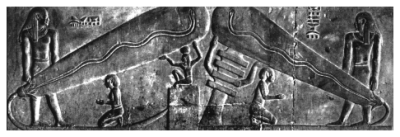
Carbon arc
searchlights in a Denderah temple crypt
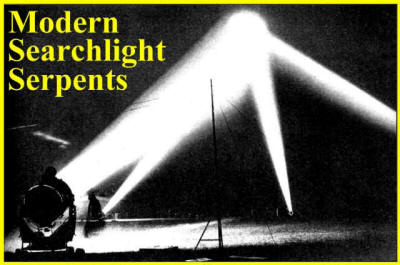
The extensive proofs provided in The
Electric Mirror on the Pharos Lighthouse and Other Ancient Lighting
[xi] clearly demonstrate
that "possibility."
This work also includes excellent
reproductions of the extraordinary ancient illustrations discovered
on the crypt walls beneath the
Temple of Hathor (Isis) at Denderah.
They seem to clearly portray electric carbon arc searchlights and
filament bulbs. Priests apparently used them to illuminate the
temple as well as various tombs - and more importantly, the mighty
Pharos Lighthouse. So M. Bouriant's casual suggestion
that the ancient Egyptians may have employed electric lights is no
longer a laughing matter.
With reference to the remarkable cleanliness of one particular
ancient Egyptian tomb, Dr. F. L. Griffith, Professor of
Egyptology at the University of Oxford, in an article entitled
"The Religious Revolution in Egypt," wrote:
"There are few examples of rock
architecture in Egypt more pleasing than this admirably
proportioned, spotlessly white sepulcher of one who as governor
of Akhenaton ranked as head of the notables. It is cut in the
limestone cliffs that form a semicircle round the plain of Tell
el-Amarna." [xii]
Deep, dark tombs like this one would
have required an electric light to illuminate them enough for
ancient artisans to have embellished their walls with the correctly
colored and finely detailed images of the deceased's life.
They
could never have succeeded with the light from dim candles, sloppy
oil lamps, or smoky torches that would have starved them of
essential oxygen and left unsightly soot marks clinging all over the
tomb walls and ceilings.
Several writers have suggested that the ancient Egyptians
illuminated their tombs by reflecting rays of sunlight with an
arrangement of mirrors.
However, light-absorbing mirrors are not
a good option for pressing and complex projects demanding more than
the Sun's periodic appearance - in cloudless, dust-free, daylight
skies.
Beside this, the maze of rooms in some
tombs would have caused insurmountable problems for technicians
trying to keep a large number of mirrors critically aligned and
continuously tracking one another as they tried to catch and bounce
around the diminishing rays of our elusive sun. Moreover, some
technician or artisan confined in a complex Egyptian tomb would have
eventually stepped in front of one of the reflectors and have broken
a critical link in the intricate chain of light - abruptly leaving
others down the line struggling in total darkness.
Furthermore, artisans using oil-fired lights could have never
completely removed the soot from the ceilings and walls after
finishing their tasks because they would have had to clean up the
smudge with the same smoke-belching lights that produced it. So how
else, other than with the use of clean-burning electric lamps, could
they have managed to meticulously decorate about 400 underground
grave systems with no trace of any smoke residue?
Of course, some tombs now show soot
marks left from the oil lights of grave robbers who had previously
violated them - but Lockyer spoke of "freshly-opened tombs."
Beside all this common sense that strongly supports the need for
ancient electric lighting stands several outstanding examples of
ancient testimony that cannot be reasonably explained in any other
way.
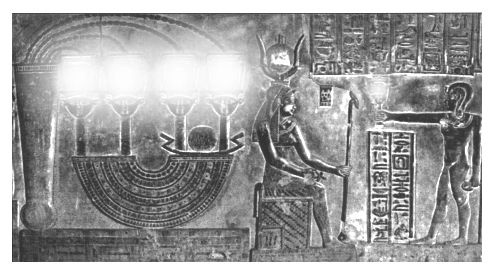
An animated photo of
ancient electric lights in a Denderah crypt
In the second century, a Syrian temple
sheltered a statue of a goddess with one of these types of lights
mounted on her head.
Writing at the time, Lucian of
Samosata on the Euphrates says:
"She bears on her head a stone
called a 'lamp,' and it receives its name from its function.
That stone shines in the night with great clarity and provides
the whole temple with light, as with [oil] lamps. In the
daytime, it shines dimly, but has a very fiery aspect."
[xiii]
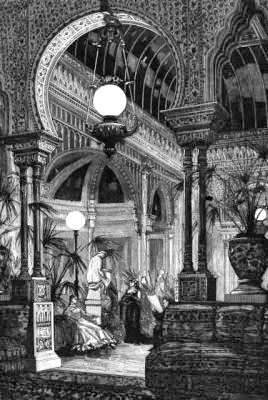
Carbon arc lights
hanging in a 19th-century French Hotel
This obviously seems like some type of
electric light since Lucian clearly called the stone a "lamp" - and it
was powerful enough to light up the whole temple. Furthermore, an
electric light, any type for that matter, typically shines brightly
at night and very dimly in the daytime.
However, since Lucian called the
lamp a "stone," perhaps it was the only way he knew how to describe
carbon, the carbon of a simple electric arc lamp.
And, since he said it had a "very fiery
aspect" in the daytime, this makes us think that it might have been
some kind of fiery carbon arc light - like those used to illuminate
nineteenth-century cities and to power searchlights.

St. Augustine's demon
arc light
A couple of centuries later, in his
City of God, St. Augustine (354 - 430 A.D.) pointed out that in
Egypt,
"There was, and still is, a temple
of Venus, in which a lamp burns so strongly in the open air that
no storm or rain extinguishes it."
He blamed "the reality" of this
marvelous lamp, likely an electric arc light, on the miracles of the
"black arts" performed by demons and men [the illuminati].
He also wrote:
"We add to that inextinguishable
lamp a host of other marvels of human and of magical origin - that
is miracles of the demon's black arts performed by men, and
miracles performed by the demons themselves. If we choose to
deny the reality of these, we shall ourselves be in conflict
with the truth of the sacred books in which we believe.
Thus, either human ingenuity has
devised in that inextinguishable lamp some contrivance based on
the asbestos stone or else it was contrived by magic art to give
men something to marvel at in that shrine; or perhaps some demon
presented himself there under the name of Venus with which such
effect that this prodigy was displayed to the public there and
continued there for so many years."
[xiv]
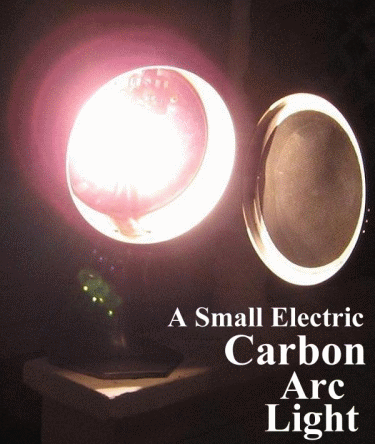
An arc light from the
collection of Larry Brian Radka
This church father also claimed
that the,
"asbestos stone, which has no fire
of its own, and yet, when it has received fire, blazes so
fiercely with a fire not its own that it cannot be quenched."
This points to the carbon in an arc
light receiving its fire from an electric source - an ancient
battery - "not its own."

"It is quite
independent of the action of the air."
Furthermore, he also claimed "no
storm or rain extinguishes it."
This also points to the electric arc
light because Chamber's Encyclopaedia maintains that it,
"can be produced in a vacuum, and
below the surface of water, oils, and other non-conducting
liquids, and it is thus quite independent of the action of the
air." [xv]
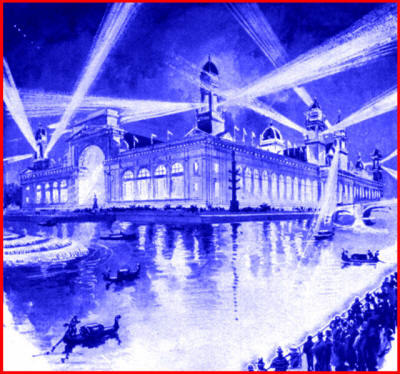
Carbon arc
searchlights beaming out of the Electric Building at Chicago's 1893
Exposition
A couple of hundred years later,
carbon arc light technology still survived.
Electric
searchlights nightly lit up Jerusalem then, and a substantial
portion of it at that, by casting their beams a great distance from
another holy edifice - the circular Church of the Ascension on
the Mount of Olives.
Arculf (Arculfus), a Frankish
bishop, perhaps of Périgueux, who visited and explored the Holy
Land, accompanied by Peter, a Bergundian monk, who acted as a guide,
reported the details and effects of eight brilliant lights - and some
others also.
The Catholic Encyclopedia
[xvi] gives us a little
background on his marvelous report - as follows:
"St. Bede relates (Hist. Eccles.
Angl., V, 15) that Arculf, on his return from a pilgrimage to
the Holy Land about 670 or 690, was cast by tempest on the shore
of Scotland.
He was hospitably received by
Adamnan, the abbot of the island monastery of Iona, to whom he
gave a detailed narrative of his travels to the Holy Land, with
specifications and designs of the sanctuaries so precise that
Adamnan, with aid from some extraneous sources, was able to
produce a descriptive work in three books, dealing with
Jerusalem, Bethlehem, the principal towns of Palestine, and
Constantinople.
Adamnan presented a copy of this
work to Aldfrith, King of Northumbria in 698. It aims at
giving a faithful account of what Arculf actually saw during his
journey. As the latter 'joined the zeal of an antiquarian to the
devotion of a pilgrim during his nine months' stay in the Holy
City, the work contains many curious details that might
otherwise have never been chronicled.'"
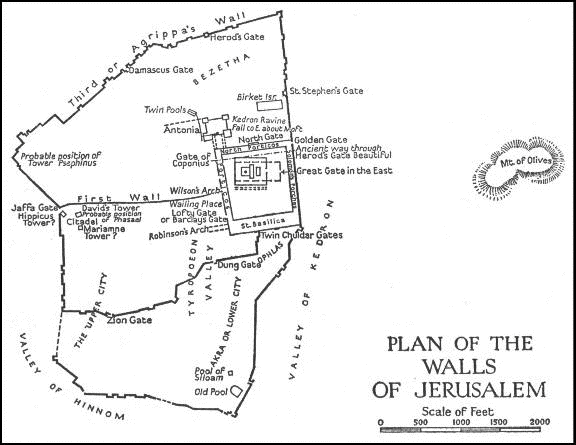
The following two excerpts, from The
Pilgrimage of Arculfus in the Holy Land (About the Year A.D.
670) was translated by the Rev. James R. MacPherson in 1895.
He says:
"The translation has been made as
literal as possible in passages where the exact rendering was of
any controversial or archaeological importance, as in the
description of the sites and buildings."
Here are those excerpts, describing one
of the buildings and the effects of its bright electric
searchlights:
"In the western side of the church
we have mentioned above [before], twice four windows have been
formed high up with glazed shutters, and in these windows there
burn as many lamps placed opposite them, within and close to
them. These lamps hang in chains, and are so placed that each
lamp may hang neither higher nor lower, but may be seen, as it
were, fixed to its own window, opposite and close to which it is
specially seen.
The brightness of these lamps is so
great that, as their light is copiously poured through the glass
from the summit of the Mountain of Olivet, not only is the part
of the mountain nearest the round basilica to the west
illuminated, but also the lofty path which rises by steps up to
the city of Jerusalem from the Valley of Josaphat is clearly
illuminated in a wonderful manner, even on dark nights; while
the greater part of the city that lies nearest at hand on the
opposite side is similarly illuminated by the same brightness.
The effect of this brilliant and
admirable coruscation of the eight great lamps shining by night
from the holy mountain and from the site of the Lord's
ascension, as Arculf related, is to pour into the hearts of the
believing onlookers a greater eagerness of the Divine love, and
to strike the mind with a certain fear along with vast inward
compunction."
"This also we learned from the narrative of the sainted Arculf:
That in that round church, besides the usual light, of the eight
lamps mentioned above as shining within the church by night,
there are usually added on the night of the Lord's Ascension
almost innumerable other lamps, which by their terrible and
admirable brightness, poured abundantly through the glass of the
windows, not only illuminate the Mount of Olivet, but make it
seem to be wholly on fire; while the whole city and the places
in the neighborhood are also lit up."
[xvii]
Ancient candles and oil lamps could
never have begun to light up a "whole city" a mile away, but
Arculf's electric mirrors (searchlights), as described above, were
quite adequate.
However, the wily priests maintaining
the bright lamps in ancient lighthouses, temples, and tombs kept
their searchlight technology a secret because they needed to inspire
their naïve flocks to revere their religion. Yet, they could not
resist bragging to succeeding generations of illuminati - by cleverly
emblazoning their electrical wisdom on their monuments.
Unfortunately, until relatively
recently, not many people have taken seriously the ancient
electric lighting testimony left to us - although the proof and
techniques have stood out in front of our eyes for thousands of
years now. The ancient electrical wizards must be disgusted with
their failure to induce productive observation in modern
generations, or perhaps they are laughing loudly somewhere at our
blind wisdom of the past instead.
What electrical truth Edison and others stumbled onto in the
nineteenth century is merely old wine poured into a new bottle,
and the bible verifies this by maintaining that there is nothing new
under the sun. Yet, our pride often seems to stand in the way of
accepting the fact.
However, one wise writer set this human weakness aside and boldly
admitted the truth - over a century ago!
"Whenever, in the pride of some new
discovery, we throw a look into the past, we find, to our
dismay, certain vestiges which indicate the possibility, if not
the certainty, that the alleged discovery was not totally
unknown to the ancients," wrote Madame H. P. Blavatsky,
in Isis Unveiled.
"It is generally asserted that
neither the early inhabitants of the Mosaic times, nor even the
more civilized nations of the Ptolemaic period were acquainted
with electricity. If we remain undisturbed in this opinion, it
is not for the lack of proofs to the contrary."
[xviii]
REFERENCES
[i] "A Shocking Discovery,"
Journal of the Electrochemical Society, September 1963, Vol.
110 No. 9
[ii] Under SCIENCE ARTICLES in the March 1939 issue of
ASTOUNDING magazine, Willy Ley's article was listed on the
contents page as "ELECTRIC BATTERIES - 2,000 YEARS AGO! SO
YOU THOUGHT OUR CIVILIZATION FIRST DISCOVERED ELECTRICITY?"
[iii] Secrets of the Lost Races, New Discoveries of Advanced
Technology in Ancient Civilizations, New York 1977
[iv] A History of Technology, Volume II, London 1956
[v] Harper's New Monthly Magazine, No. CCXLVI, November
1870, Volume XLI
[vi] "A Survey of the Chemistry of Assyria in the Seventh
Century B.C.," Ambix, Vol. II, No. 1, June 1938
[vii] Encyclopaedia Britannica, 14th Edition, Article: "Battery
- Lalande Cell," London 1929
[viii] A Popular Account of the Ancient Egyptians, New York
1988
[ix] In The Crystal Sun, Rediscovering a Lost Technology of
the Ancient World, London 2000
[x] The Dawn of Astronomy, M.I.T. Press, Cambridge 1964 (a
reprint of Lockyer's 1894 first edition)
[xi] Published by The Einhorn Press, Parkersburg, West
Virginia in 2006 and edited by the author of this article
[xii] J. A. Hammerton's Universal World History, Volume II,
New York 1937
[xiii] Lucian, Loeb Classical Library, Volume IV, New York
1925
[xiv] Concerning the City of God Against the Pagans,
numerous editions are available
[xv] Chamber's Encyclopaedia, A Dictionary of Universe
Knowledge for the People, New York 1890
[xvi] The Catholic Encyclopedia, in 15 volumes, New York
1907
[xvii] The Library of the Palestine Pilgrim' Text Society,
Volume III, London 1894
[xviii] Isis Unveiled, A Master Key to the Mysteries of
Ancient and Modern Science and Theology, New York 1877
|


















